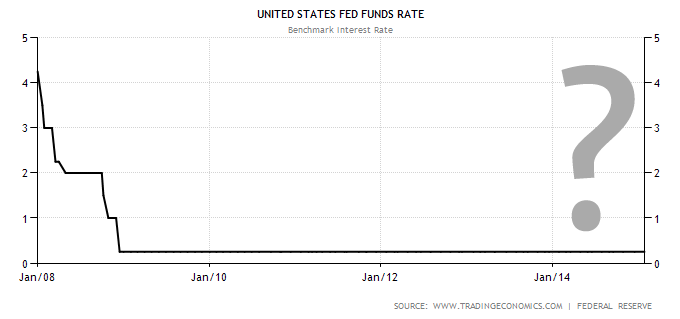American interest rates are going to rise – we just don’t know when, but soon, maybe – seems to be the outcome of this morning’s Fed statement, economic forecasts and post meeting media conference by chair, Janet Yellen.
The Fed, as expected, removed the word ‘patient’ from its statement, but added another qualifier, more wordy, which basically says the central bank will wait to get more data, especially on inflation and jobs, before moving rates up.
But there will be at least one rate rise this year – possibly in August or September, but after April. There could be a second, but not a third.
Confused? Well, the markets and traders weren’t – we saw one of the great short bursts of bullish/dotty trading we have seen for ages in the two hours or so after the Fed’s statement was released, with rarely seen rises in the value of the euro and falls in the greenback.
Shares rose on Wall Street, the US dollar fell, but the Aussie soared, as did ASX futures, oil fell, then rose and gold went for a big gallop.
But the boomlet conditions will be tempered here by a 5% plunge in the spot iron ore price to less than $US55 a tonne. It reached $US54.50 a tonne, down 5.4% from its previous close of $US57.60 a tonne. It’s now down close to 16% from last Thursday!
That will pressure iron ore miners, starting with Fortescue, which was forced to abandon a big fund raising yesterday.
All in all the fallout from the Fed’s two day meeting this week has been to set up a period of more gains (and some losses though) for equities because there’s now a realisation US rates will be lower for longer, and slower to rise when they do.
The realisation is all down to a plot chart of where the Fed’s 17 members reckon US rates will be later this year – there now seems to be consensus they will be around 0.6 to 0.75%, half the 1.12% seen in a similar plot chart issued after the December meeting.
I know it sounds esoteric, but it’s taken very seriously by US markets and traders who immediately came to the conclusion the Fed would be slower to lift interest rates this year and next.
When will the Fed hike rates?

So Wall Street soared, trading in a 400 point range on the day – the Dow was down well over 150 points early on, but finished the day up 227, or 1.27%. the Nasdaq rose 0.9% and the key S&P 500 index jumped 1.2% or 25 points.
That in turn sparked a turnaround in the local market’s futures trading this morning. After being down 34 points before the Fed statement, the share futures contracted ended the session up more than 20 points.
The Australian dollar soared over 77 US cents and over 78 US cents, no doubt bringing a groan from the Reserve Bank. The euro jumped from around $US1.0650 to more than $US1.10 in the same time.
US oil futures fell 0.3% before the statement was released – they started trading in Asia up more than 3% and over $US45 a barrel, despite a huge jump in US oil stocks last week to more than 458 million barrels.
Gold futures jumped more than 2%, or $US25 to $US1172 an ounce in early Asian dealing on the Comex electronic platform. Other commodities rose as well.
While the Fed dropped the word “patient” from its guidance on interest rates, it also scaled back expectations on how fast it will move, indicating the first rate rise might not take place until September. The bank even said an increase in rates at its April meeting “remains unlikely.”
In it’s newly reworked statement, the Fed said it would be appropriate to raise rates once “it has seen further improvement in the labor market and is reasonably confident that inflation will move back to its 2% objective over the medium term.”
The Fed’s caution was shown with its concession that US “economic growth has moderated somewhat.” Now the bank expects rates to rise just half as quickly as it did in December, and it was that which caught the eye of markets and triggered the surges and slides in what can only be described as dotty trading.
Underpinning the belief rates would be slower and lower for the next year or so was downgrades by the Fed members and staff of forecasts for US growth and inflation, while jobs growth will be slightly stronger and the unemployment rate lower at around 5% to 5.2% (from, 5.5% currently) by the end of this year.
While that fall in the jobless rate would have normally sparked a sell-off, it was not enough to offset the bullishness from the statement, the other forecasts and Ms Yellen’s comments in her media conference where she indicated the stronger US dollar would help trim exports, inflation and growth in the coming year.
And later this morning watch for bad news from the interim result of Myer and the full year figures from Metcash.













